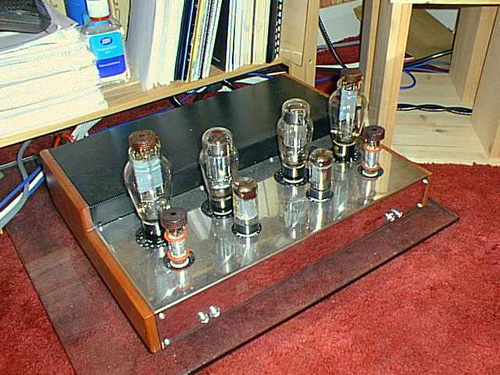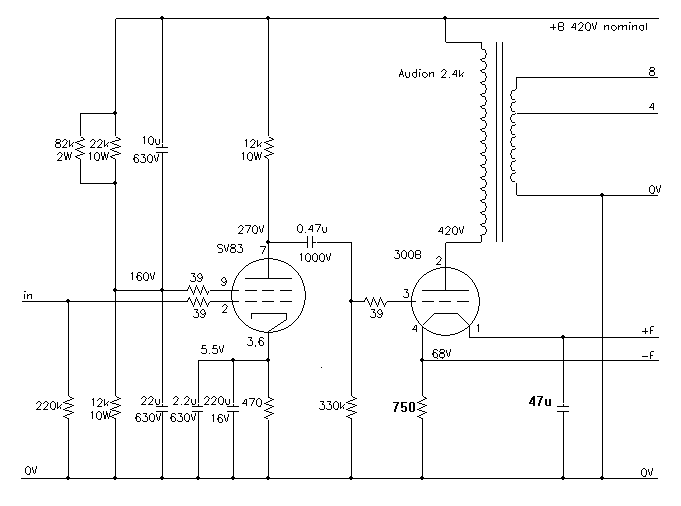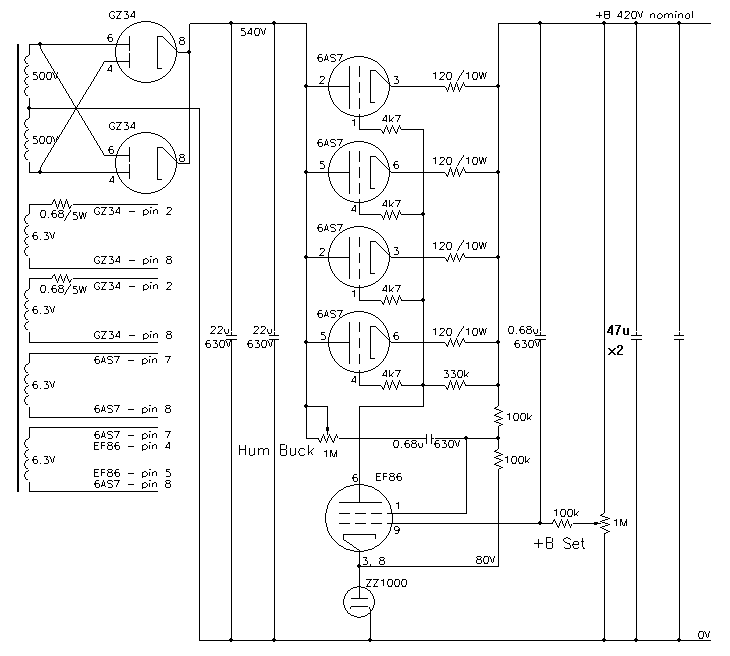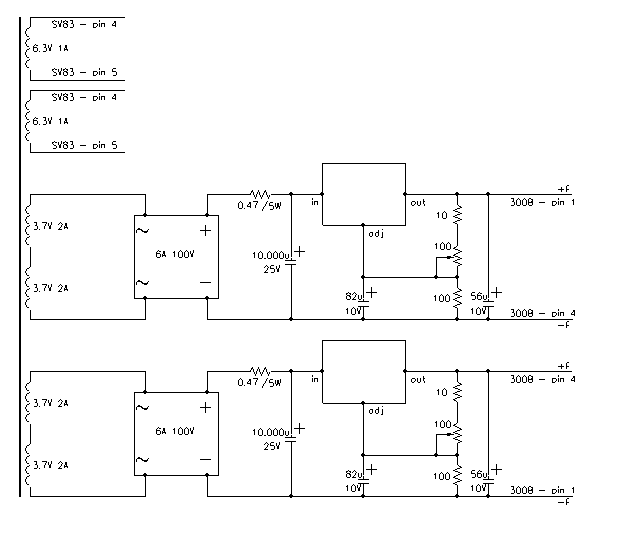
The Legacy Poweramplifier

This design is started live as a fairly faithful reproduction of the "Legacy" Amplifier from le mainson de l'Audiophile, designed by Wilhelm Walters and Jean Constine Verdier. This amplifier is among the absolute best commercially produced 300B Amplifiers I have ever encountered.
First however credit where it�s due.
ThanX to David Chessel from Alema LTD (Audion, Edison, AMP) for providing the mechanical parts and transformers of the Edison 60 Kit, which where used as the basis for Amplifier. Thanks are also due to Eric Barbour from Svetlana for samples of the Svetlana 300B and to George Hawthorne for a pair of 45 Valves. Another big round of thanX to my friend Jon Finlayson for helping to obtain many of the parts used, especially the custom designed Ansar Supersound Polypropylen Capcitors extensively used throughout the Amplifier and for getting me two pairs of the superb Siemens C3m Penthode from Australia. Also thanX to Jean Constantine Verdier for sharing his Design for the Powersupply in Sound Practices and for sharing his design of the EL84 driverstage. I'm also indebted to Ronald Koridon for suggesting this Amplifier to me.
Now to the Amplifier. In many ways this Amplifier could be called the "ultimate" WECO 91. While investigating the old WECO design I noticed many things, but one thing that stood out was simply how much lower the distortion from a correctly designed penthode driverstage is. The drawback is that in the old WECO design the very high output impedance of the Driverstage causes HF rolloff and poor delivery. In the Legacy the WE310 driver valve is replaced with a much meatier EL84 (or indeed as I did later with a Siemens C3m). This allows a output impedance of the driverstage that is by the factor ten lower than in the original WECO design and that can deliver more than eight times the current.
The driverstage with around 16mA operating current provides enough current to avoid slewing into the 300B grid for over 500kHz Bandwidth and is in conjunction with the output impedance and the 300B input capacitance naturally limited to 190kHz, so the driverstage will under NO conditions run into slewing. The not inconsiderable grid current of the 300B on peaks can also be accommodated, allowing better power delivery. Essentially, the Driverstage on this Amplifier is not the limiting factor both with regards to bandwidth and linearity.
The 300B output valve and the output transformer dominate the performance of this Amplifier entirely. For the output valve many options exist, mostly you get what you pay for.... I like Svetlana and WE 300B's best, but the latest batch of Reflektor (Sovtek) 300B Valves I obtained has also got most excellent and is close to the Svetlana, much better than the earlier Sovtek 300B's. The Output Transformer I used is the one from the Edison 60 kit. Especially in this amplifier it is a heavily overdimensioned part, with a huge core and power capacity. The Primary inductance is high enough to allow the transformer to be mismatched (connect a 8 Ohm load to the 4 Ohm Tap) thus giving basically the option for a 4800 Ohm nominal primary Impedance, useful with many of the interesting RCA Valves (45, 50) as we will see later.
The audio circuit for one channel is shown below, as seen, apart from the beefier driverstage it is classic WECO. The driver valve can be a Svetlana SV83 or any other EL84 compatible Valve.

I have since drawing this circuit changed the driver valve over to the Siemens C3m (TS49/PT49 are equivalents). The changes are minimal, the 82k Resistor in the Voltage divider for G2 is removed and the Cathode resistor becomes 250 Ohm, the anode Voltage is nominally 225V. Of course it is necessary to fit a loctal socket for the C3m and the pinout is different.
One of the main innovations of this Amplifier is actually the Powersupply. It is fully regulated using Valves. I will not particularly insist upon the benefits of such an arrangement. Instead I suggest to read Jean Constantine Verdiers excellent Sound Practices Article. I progressed further from the original Design. After comparing the sound of a Neon Reference against zenner diodes I found myself preferring this and have kept the neon reference.
In addition I have tuned the PSU open loop bandwidth and gain so that above around 150Hz the PSU no longer carries the signalcurrent; instead it hands over to a pair of 47uF/450V Ansar Supersound capacitors. Thus the PSU delivers a low impedance PSU at very low frequencies where a ridiculously large value capacitor would be needed otherwise, while in the range where most musical information resides the PSU impedance is determined by the very high quality capacitors. The rectification uses GZ34 Valves. This delivers a slow turnon and allows for the Resistor bridging across the Regulator Valves in the original design to be dispensed with, offering again improved soundquality.
Using two rectifier Valves and only 40uF total reservoir capacity makes for a raw unregulated +B that is pretty brawny but fast and that reduces the pulsing of the mains transformer. This leads of course to a lot of ripple, however the active regulation offers tremendous levels of ripple suppression, offering a fantastically low level of hum, less than 10mV on the 420V rail under full load. The output hum of the Amplifier in system is at around 0.5mV when adjusted optimally.

The supply for the heaters is simple; a LT1085 is used in each channel to regulate the heater voltage for the output Valve. As shown the PSU allows adjustment over the full 2.5V to 7.5V range allowing a wide range of output valves to be accommodated. At 2.5V the full 2.5A for a 2A3 can be supplied, at 7.5V the current capacity lowers to around 1.5A.

The parts quality used in the amplifier is at my usual high standards. All capacitors in the PSU and the 300B Cathode bypass capacitors are Ansar Supersound, metalcan encased, custom made metalised Polypropylen. The Capacitors bypassing G2 for the driverstage are also Ansar, conventional ones however. The Cathode bypass Capacitor for the driver valve is a Elna Silmic, with further bypassing using Ansar Supersound. The Coupling Capacitor is a ERO KP1832 unit from Steinmusic in Germany.
All capacitors feature the complete recommended bypassing with 3600pF ERO KP1832, 2700pF NFS Styrofoam and a further 2200pF Silver Mica unit. Larger Value capacitors have a further ERO KP1832 0.075uF 800V bypass capacitors.
All resistors are my usual NOS noninductive, nonmagnetic wirewound resistors; the closest modern equivalent is Mill or Dale. Gridstoppers and the 300B gridleak resistor are Allen Bradley Carbon Composite. All adjustable resistors are 18 Turn Vishay Cermet types. Internal wiring is mostly solid silver in teflon with solidcore copper in PTFE isolation for the PSU wiring. All components are hardwired, no PCB.
The amplifier sounds very good, with excellent bass and control. It has easily withstood comparisons with many highly regarded commercial 300B SET Amplifiers.
The Amplifier has been voiced with Beauhorn Virtuoso Speakers but also been used with a wide range of Speakers, including the 89db/W/m 4Ohm Orchid Audio PLL-1 Monitors and all the way to my own 102db/W/m sensitive "Magnificat" Speakers and electrostatic speakers as well. The amplifier has been used with a wide range of output valves, including most current makes of 300B, various new and old stock 2A3 valves and 45 Valves, offering tremendous sound in case, according to the valve used. I mostly use Svetlana 300B output Valves.
Power with the 300B and at notional settings (425V +B) is 8 Watt.
Below some more pictures:
Legacy with C3m Driver and 45 Output Valves